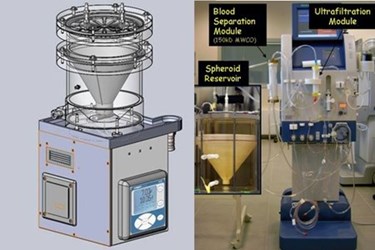Mayo Clinic Tests Bioartificial Liver

Researchers at the Mayo Clinic are testing an artificial liver device that could provide an alternative to liver transplants for patients with acute liver failure (ALF). Pre-clinical testing on pigs showed that the device could not only stop progression of the disease, it also could help the diseased liver repair itself.
The liver is responsible for filtering toxins from the body and when liver function stops, a patient deteriorates quickly. Though the liver is an organ capable of regenerating itself, it doesn’t happen fast enough, and transplant currently is the only treatment. Due to issues with tissue rejection and donor availability, transplants are not always an option.
Mayo Clinic scientists, led by Scott Nyberg, wondered if there might be a way to buy some time for the patient’s liver to get itself back on track.
“In the United States,” states Nyberg on the Mayo Clinic’s research website, “there is not an approved device for such a treatment. There is no liver dialysis.”
The scientists’ solution was to design a Spheroid Reservoir Bioartificial Liver (SRBL), a bedside device that uses healthy liver cells from pigs to filter and clean the patient’s blood, removing that burden from the diseased liver while it repairs itself.
“Acute liver failure claims the lives of over 30 percent of people who are diagnosed with the condition. A bioartificial liver device could allow physicians to treat and extend the lives of more patients, safely and cost-effectively, with fewer risks,” said Nyberg in a recent press release.
Nyberg’s team recently completed a preclinical study using the technology to treat pigs with drug-induced liver failure. The study, published in The Journal of Hepatology, showed that pigs treated with the SRBL device fared better than pigs receiving other treatments.
In a video released by the Mayo Clinic, Nyberg remarked that the study was the first ever in which a large animal was completely rescued by a treatment when all the animals in the control group died.
Study authors noted that the successes achieved with these preclinical studies warrant further clinical testing to refine their prototype.
“Although the artificial liver is not yet cleared for use on humans, these findings show promise as an effective treatment option for diseases like liver cancer and hepatitis, which is becoming an increasingly common diagnosis,” said Nyberg in the press release.
According to the American Liver Foundation, there are more than 100 kinds of liver disease, and over 30 million Americans — one in 10 — have some form of the condition. Currently, there are more than 16,000 adults and children on a waiting list for a liver transplant.
The SRBL treatment recently was licensed to Liver Cell Technologies for commercial development.
